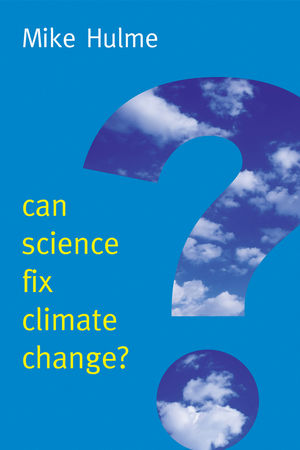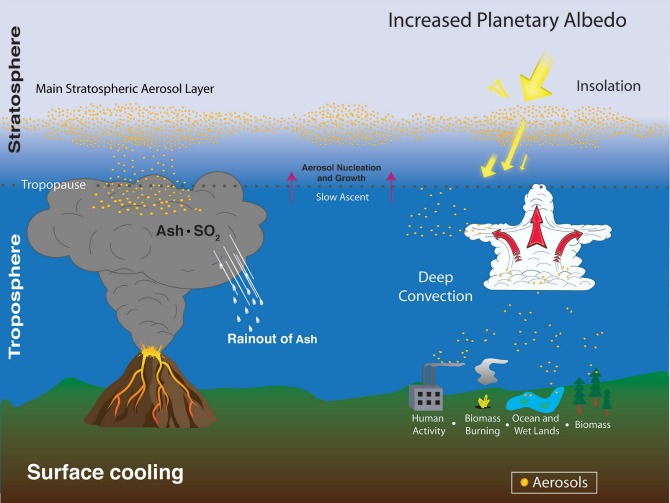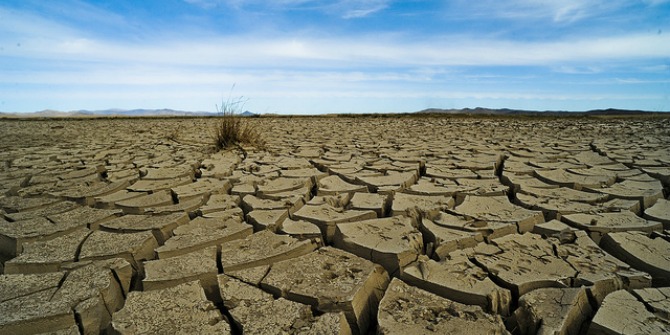 As political solutions to climate change have so far had little impact, some climate change scientists are now advocating the so-called ‘Plan B’, a more direct way of reducing the rate of future warming by reflecting more sunlight back to space, creating a thermostat in the sky. In this book, Mike Hulme argues against this kind of hubristic techno-fix. Amelia Sharman is impressed by Hulme’s interesting proposals.
As political solutions to climate change have so far had little impact, some climate change scientists are now advocating the so-called ‘Plan B’, a more direct way of reducing the rate of future warming by reflecting more sunlight back to space, creating a thermostat in the sky. In this book, Mike Hulme argues against this kind of hubristic techno-fix. Amelia Sharman is impressed by Hulme’s interesting proposals.
 Can Science Fix Climate Change? Mike Hulme. Polity Press. 2014.
Can Science Fix Climate Change? Mike Hulme. Polity Press. 2014.
While the premise of Mike Hulme’s latest book is relatively simple — that, while superficially appealing, the geoengineering techno-fix of stratospheric aerosol injection (SAI) is not the silver bullet we should be looking for to ‘solve’ climate change — there is more to this slim volume than meets the eye. In this brief, yet eloquently argued volume, Hulme strongly cautions against rushing into planetary-scale experiments that we neither fully understood, nor necessarily need.
Hulme brings numerous concepts from the social sciences to bear on his argument, from governmentality to the precautionary principle and the risk society. However I think one of the most interesting ideas he uses is drawn from LSE’s own Craig Calhoun, which is that not only is the discourse of the emergency central to international affairs, but that this self-constituting discourse also contains an inherent assumption that emergencies can and should be managed. Applied to climate change, Hulme suggests that the idea of a planetary emergency (exemplified by the notion of tipping points and the call to limit temperature increases to no more than two degrees Celsius) operates as a fundamental rationale for geoengineering, changing the scope of justifiable actions and legitimate actors. Essentially, once it is decided that climate change is an emergency, we must act immediately—no time can be wasted evaluating the potential ethical, political or legal consequences that may arise. However, Hulme strongly disputes this notion and brings up many salient and quite practical points in opposition, such as by whom should it be decided and at what cost?
But what is SAI and why does Hulme argue so vehemently that it is “undesirable, ungovernable and unreliable” (p.xii)? SAI aims to replicate what happens in the atmosphere when large volcanic eruptions occur. As the NASA diagram below explains, after being expelled from the volcano and reaching the stratosphere, sulphur dioxide gas is converted to droplets of sulphuric acid (through oxidisation) which then reflect the energy coming from the sun. SAI would involve the artificial injection of millions of tonnes of sulphur gases into the stratosphere. These tiny oxidised particles of sulphuric acid could survive for a number of years, helping to reduce global warming by reducing the amount of sunlight reaching the Earth’s atmosphere.

Hulme is particularly concerned about this type of geoengineering (as opposed to for example, ocean fertilisation or carbon capture and storage) because it is most likely to be implemented based on cost relative to (potential) effectiveness, it has received legitimacy from well-regarded scientists and is actively debated in policy circles, and, most importantly, that despite the illusion of control over the Earth given by the idea of a ‘global temperature’, the significant environmental, social, ethical and political risks of SAI have been hugely under-analysed and debated. As the quintessential ‘wicked’ problem, Hulme contends that climate change is not the type of problem best addressed by technological end-of-pipe solutions.
He suggests that SAI is undesirable because not only is it problematic to reduce “weather and human welfare to a function of global temperature” (p.36) but that regulating global temperature is something quite different from controlling regional climate systems and thus local weather (as well as being potentially technically impossible). In an effort to stabilise global temperature, it is extremely likely that regional climates will become increasingly unstable, thus leading to his next argument, that SAI is an ungovernable solution to climate change. For example, if some climates are likely to improve while others suffer, it is unsurprising that SAI could “open up a new frontier in the sky for inter-state rivalry, conflict and disagreement” (p.53). Even if unilateral state or region-level SAI projects were rejected, given the challenges experienced by the Intergovernmental Panel on Climate Change process, it is unlikely that global negotiations to govern geoengineering research or deployment of SAI technology would fare much better. Finally, Hulme argues that due to the inherent unreliability of SAI, humanity is exposing itself to unknown, unforeseeable risks (i.e. Donald Rumsfeld’s ‘unknown unknowns’) which would “forever alter our sense of moral duty and ethical responsibility” (p.93). This includes research and experimentation into SAI as once the technology is deployed, there is no turning back.

In his conclusion Hulme calls for a reframing of climate change as a problem, highlighting the potential for the (controversial) notion of climate pragmatism and increased pluralism in climate change decision-making. While it does seem improbable that full global democratic decision-making would occur, even for such a potentially game-changing technology, it is clearly still critical to aim for. And while the cynic in me suggests that it seems unlikely that research into SAI will completely stop despite its potential (and likely) risks, particularly given the vocal arguments made from some quarters about the necessity to ‘buy time’ until a transition to a low carbon economy is achieved—look what’s happened with genetically modified organisms—his logic appears well thought out and convincing.
The other somewhat unique element of the book is his concluding call for greater humility and virtue. Hulme notes that solutions to climate change must “appeal to plural, even contradictory, human values” (p.122) and his most recent essay, Climate change and virtue: an apologetic expands these ideas further, suggesting that putting the question of what it means to be human at the core of the debate may be a more practical, and productive, strategy, than current efforts.
However, what I think is the main things that makes Can Science Fix Climate Change? worthy of a read is that it is about more than geoengineering, but can also be seen as a contribution to the vast and fascinating literature about nature—how it can be defined, whether we consider ourselves as human beings part of, or separate from the environment around us, and what our role should be in stewarding or mastering the Earth (or somewhere in-between). This book doesn’t say anything particularly new for readers already deeply engaged in ethical debates about science and technology, but is interesting for non-specialists, particularly in the way that it applies some quite abstract philosophical concepts to a concrete example.
Amelia Sharman is a PhD student at the Grantham Research Institute on Climate Change and the Environment at the LSE. Her main research interests are in the relationship between science and policy, and uncertainty and controversy in political decision-making. Previously, Amelia was a Sustainability Specialist at the International Hydropower Association and a Senior Policy Advisor at the New Zealand Ministry for Economic Development. Read more reviews by Amelia.








5 Comments